Haozheng Luo
AdvEvo-MARL: Shaping Internalized Safety through Adversarial Co-Evolution in Multi-Agent Reinforcement Learning
Oct 02, 2025Abstract:LLM-based multi-agent systems excel at planning, tool use, and role coordination, but their openness and interaction complexity also expose them to jailbreak, prompt-injection, and adversarial collaboration. Existing defenses fall into two lines: (i) self-verification that asks each agent to pre-filter unsafe instructions before execution, and (ii) external guard modules that police behaviors. The former often underperforms because a standalone agent lacks sufficient capacity to detect cross-agent unsafe chains and delegation-induced risks; the latter increases system overhead and creates a single-point-of-failure-once compromised, system-wide safety collapses, and adding more guards worsens cost and complexity. To solve these challenges, we propose AdvEvo-MARL, a co-evolutionary multi-agent reinforcement learning framework that internalizes safety into task agents. Rather than relying on external guards, AdvEvo-MARL jointly optimizes attackers (which synthesize evolving jailbreak prompts) and defenders (task agents trained to both accomplish their duties and resist attacks) in adversarial learning environments. To stabilize learning and foster cooperation, we introduce a public baseline for advantage estimation: agents within the same functional group share a group-level mean-return baseline, enabling lower-variance updates and stronger intra-group coordination. Across representative attack scenarios, AdvEvo-MARL consistently keeps attack-success rate (ASR) below 20%, whereas baselines reach up to 38.33%, while preserving-and sometimes improving-task accuracy (up to +3.67% on reasoning tasks). These results show that safety and utility can be jointly improved without relying on extra guard agents or added system overhead.
Evo-MARL: Co-Evolutionary Multi-Agent Reinforcement Learning for Internalized Safety
Aug 05, 2025


Abstract:Multi-agent systems (MAS) built on multimodal large language models exhibit strong collaboration and performance. However, their growing openness and interaction complexity pose serious risks, notably jailbreak and adversarial attacks. Existing defenses typically rely on external guard modules, such as dedicated safety agents, to handle unsafe behaviors. Unfortunately, this paradigm faces two challenges: (1) standalone agents offer limited protection, and (2) their independence leads to single-point failure-if compromised, system-wide safety collapses. Naively increasing the number of guard agents further raises cost and complexity. To address these challenges, we propose Evo-MARL, a novel multi-agent reinforcement learning (MARL) framework that enables all task agents to jointly acquire defensive capabilities. Rather than relying on external safety modules, Evo-MARL trains each agent to simultaneously perform its primary function and resist adversarial threats, ensuring robustness without increasing system overhead or single-node failure. Furthermore, Evo-MARL integrates evolutionary search with parameter-sharing reinforcement learning to co-evolve attackers and defenders. This adversarial training paradigm internalizes safety mechanisms and continually enhances MAS performance under co-evolving threats. Experiments show that Evo-MARL reduces attack success rates by up to 22% while boosting accuracy by up to 5% on reasoning tasks-demonstrating that safety and utility can be jointly improved.
Learning to Rank Chain-of-Thought: An Energy-Based Approach with Outcome Supervision
May 21, 2025Abstract:Mathematical reasoning presents a significant challenge for Large Language Models (LLMs), often requiring robust multi step logical consistency. While Chain of Thought (CoT) prompting elicits reasoning steps, it doesn't guarantee correctness, and improving reliability via extensive sampling is computationally costly. This paper introduces the Energy Outcome Reward Model (EORM), an effective, lightweight, post hoc verifier. EORM leverages Energy Based Models (EBMs) to simplify the training of reward models by learning to assign a scalar energy score to CoT solutions using only outcome labels, thereby avoiding detailed annotations. It achieves this by interpreting discriminator output logits as negative energies, effectively ranking candidates where lower energy is assigned to solutions leading to correct final outcomes implicitly favoring coherent reasoning. On mathematical benchmarks (GSM8k, MATH), EORM significantly improves final answer accuracy (e.g., with Llama 3 8B, achieving 90.7% on GSM8k and 63.7% on MATH). EORM effectively leverages a given pool of candidate solutions to match or exceed the performance of brute force sampling, thereby enhancing LLM reasoning outcome reliability through its streamlined post hoc verification process.
GenoArmory: A Unified Evaluation Framework for Adversarial Attacks on Genomic Foundation Models
May 16, 2025

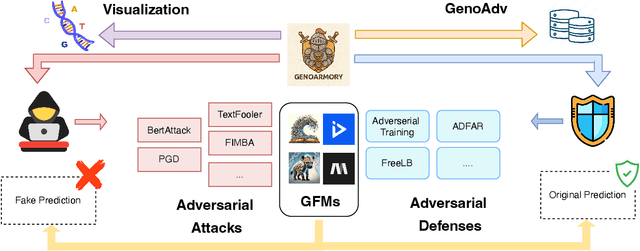

Abstract:We propose the first unified adversarial attack benchmark for Genomic Foundation Models (GFMs), named GenoArmory. Unlike existing GFM benchmarks, GenoArmory offers the first comprehensive evaluation framework to systematically assess the vulnerability of GFMs to adversarial attacks. Methodologically, we evaluate the adversarial robustness of five state-of-the-art GFMs using four widely adopted attack algorithms and three defense strategies. Importantly, our benchmark provides an accessible and comprehensive framework to analyze GFM vulnerabilities with respect to model architecture, quantization schemes, and training datasets. Additionally, we introduce GenoAdv, a new adversarial sample dataset designed to improve GFM safety. Empirically, classification models exhibit greater robustness to adversarial perturbations compared to generative models, highlighting the impact of task type on model vulnerability. Moreover, adversarial attacks frequently target biologically significant genomic regions, suggesting that these models effectively capture meaningful sequence features.
Fast and Low-Cost Genomic Foundation Models via Outlier Removal
May 01, 2025Abstract:We propose the first unified adversarial attack benchmark for Genomic Foundation Models (GFMs), named GERM. Unlike existing GFM benchmarks, GERM offers the first comprehensive evaluation framework to systematically assess the vulnerability of GFMs to adversarial attacks. Methodologically, we evaluate the adversarial robustness of five state-of-the-art GFMs using four widely adopted attack algorithms and three defense strategies. Importantly, our benchmark provides an accessible and comprehensive framework to analyze GFM vulnerabilities with respect to model architecture, quantization schemes, and training datasets. Empirically, transformer-based models exhibit greater robustness to adversarial perturbations compared to HyenaDNA, highlighting the impact of architectural design on vulnerability. Moreover, adversarial attacks frequently target biologically significant genomic regions, suggesting that these models effectively capture meaningful sequence features.
ST-MoE-BERT: A Spatial-Temporal Mixture-of-Experts Framework for Long-Term Cross-City Mobility Prediction
Oct 18, 2024



Abstract:Predicting human mobility across multiple cities presents significant challenges due to the complex and diverse spatial-temporal dynamics inherent in different urban environments. In this study, we propose a robust approach to predict human mobility patterns called ST-MoE-BERT. Compared to existing methods, our approach frames the prediction task as a spatial-temporal classification problem. Our methodology integrates the Mixture-of-Experts architecture with BERT model to capture complex mobility dynamics and perform the downstream human mobility prediction task. Additionally, transfer learning is integrated to solve the challenge of data scarcity in cross-city prediction. We demonstrate the effectiveness of the proposed model on GEO-BLEU and DTW, comparing it to several state-of-the-art methods. Notably, ST-MoE-BERT achieves an average improvement of 8.29%.
Decoupled Alignment for Robust Plug-and-Play Adaptation
Jun 04, 2024
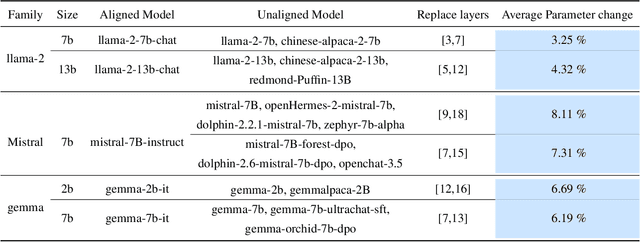

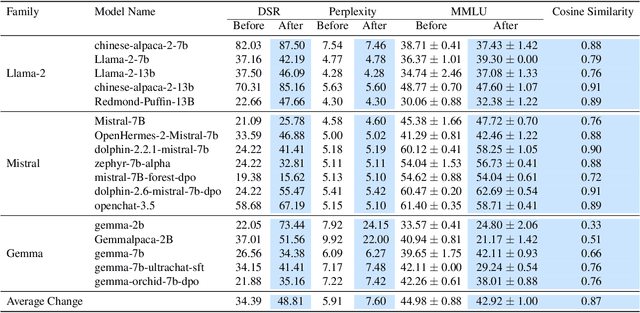
Abstract:We introduce a low-resource safety enhancement method for aligning large language models (LLMs) without the need for supervised fine-tuning (SFT) or reinforcement learning from human feedback (RLHF). Our main idea is to exploit knowledge distillation to extract the alignment information from existing well-aligned LLMs and integrate it into unaligned LLMs in a plug-and-play fashion. Methodology, we employ delta debugging to identify the critical components of knowledge necessary for effective distillation. On the harmful question dataset, our method significantly enhances the average defense success rate by approximately 14.41%, reaching as high as 51.39%, in 17 unaligned pre-trained LLMs, without compromising performance.
Enhancing Jailbreak Attack Against Large Language Models through Silent Tokens
May 31, 2024Abstract:Along with the remarkable successes of Language language models, recent research also started to explore the security threats of LLMs, including jailbreaking attacks. Attackers carefully craft jailbreaking prompts such that a target LLM will respond to the harmful question. Existing jailbreaking attacks require either human experts or leveraging complicated algorithms to craft jailbreaking prompts. In this paper, we introduce BOOST, a simple attack that leverages only the eos tokens. We demonstrate that rather than constructing complicated jailbreaking prompts, the attacker can simply append a few eos tokens to the end of a harmful question. It will bypass the safety alignment of LLMs and lead to successful jailbreaking attacks. We further apply BOOST to four representative jailbreak methods and show that the attack success rates of these methods can be significantly enhanced by simply adding eos tokens to the prompt. To understand this simple but novel phenomenon, we conduct empirical analyses. Our analysis reveals that adding eos tokens makes the target LLM believe the input is much less harmful, and eos tokens have low attention values and do not affect LLM's understanding of the harmful questions, leading the model to actually respond to the questions. Our findings uncover how fragile an LLM is against jailbreak attacks, motivating the development of strong safety alignment approaches.
Conv-CoA: Improving Open-domain Question Answering in Large Language Models via Conversational Chain-of-Action
May 28, 2024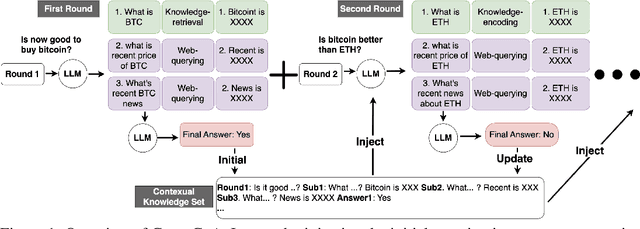
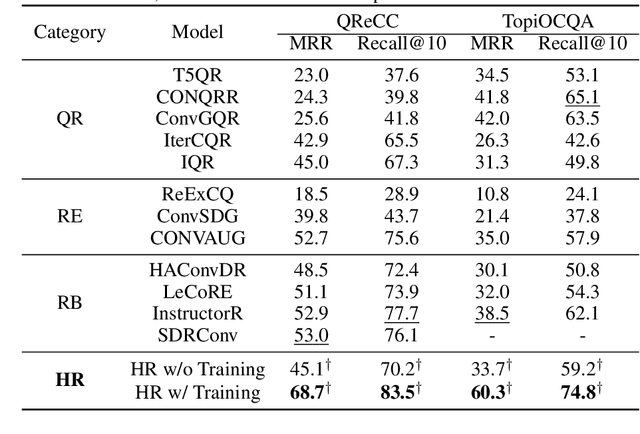

Abstract:We present a Conversational Chain-of-Action (Conv-CoA) framework for Open-domain Conversational Question Answering (OCQA). Compared with literature, Conv-CoA addresses three major challenges: (i) unfaithful hallucination that is inconsistent with real-time or domain facts, (ii) weak reasoning performance in conversational scenarios, and (iii) unsatisfying performance in conversational information retrieval. Our key contribution is a dynamic reasoning-retrieval mechanism that extracts the intent of the question and decomposes it into a reasoning chain to be solved via systematic prompting, pre-designed actions, updating the Contextual Knowledge Set (CKS), and a novel Hopfield-based retriever. Methodologically, we propose a resource-efficiency Hopfield retriever to enhance the efficiency and accuracy of conversational information retrieval within our actions. Additionally, we propose a conversational-multi-reference faith score (Conv-MRFS) to verify and resolve conflicts between retrieved knowledge and answers in conversations. Empirically, we conduct comparisons between our framework and 23 state-of-the-art methods across five different research directions and two public benchmarks. These comparisons demonstrate that our Conv-CoA outperforms other methods in both the accuracy and efficiency dimensions.
Chain-of-Action: Faithful and Multimodal Question Answering through Large Language Models
Mar 26, 2024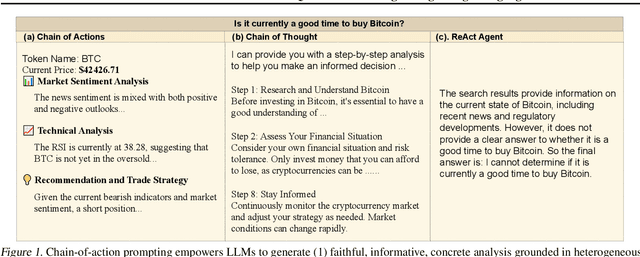


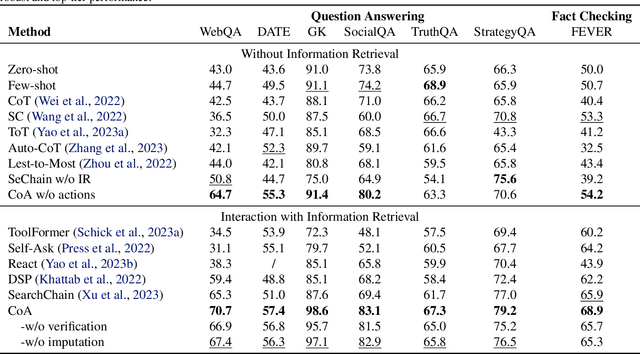
Abstract:We present a Chain-of-Action (CoA) framework for multimodal and retrieval-augmented Question-Answering (QA). Compared to the literature, CoA overcomes two major challenges of current QA applications: (i) unfaithful hallucination that is inconsistent with real-time or domain facts and (ii) weak reasoning performance over compositional information. Our key contribution is a novel reasoning-retrieval mechanism that decomposes a complex question into a reasoning chain via systematic prompting and pre-designed actions. Methodologically, we propose three types of domain-adaptable `Plug-and-Play' actions for retrieving real-time information from heterogeneous sources. We also propose a multi-reference faith score (MRFS) to verify and resolve conflicts in the answers. Empirically, we exploit both public benchmarks and a Web3 case study to demonstrate the capability of CoA over other methods.
 Add to Chrome
Add to Chrome Add to Firefox
Add to Firefox Add to Edge
Add to Edge